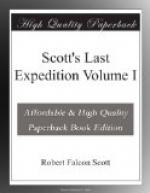We have passed some very beautiful bergs, mostly tabular. The heights have varied from 60 to 80 feet, and I am getting to think that this part of the Antarctic yields few bergs of greater altitude.
Two bergs deserve some description. One, passed very close on port hand in order that it might be cinematographed, was about 80 feet in height, and tabular. It seemed to have been calved at a comparatively recent date.
The above picture shows its peculiarities, and points to the desirability of close examination of other berg faces. There seemed to be a distinct difference of origin between the upper and lower portions of the berg, as though a land glacier had been covered by layer after layer of seasonal snow. Then again, what I have described as ‘intrusive layers of blue ice’ was a remarkable feature; one could imagine that these layers represent surfaces which have been transformed by regelation under hot sun and wind.
This point required investigation.
The second berg was distinguished by innumerable vertical cracks. These seemed to run criss-cross and to weaken the structure, so that the various seracs formed by them had bent to different angles and shapes, giving a very irregular surface to the berg, and a face scarred with immense vertical fissures.
One imagines that such a berg has come from a region of ice disturbance such as King Edward’s Land.
We have seen a good many whales to-day, rorquals with high black spouts—Balaenoptera Sibbaldi.
The birds with us: Antarctic and snow petrel—a fulmar—and this morning Cape pigeon.
We have pack ice farther north than expected, and it’s impossible to interpret the fact. One hopes that we shall not have anything heavy, but I’m afraid there’s not much to build upon. 10 P.M.—We have made good progress throughout the day, but the ice streams thicken as we advance, and on either side of us the pack now appears in considerable fields. We still pass quantities of bergs, perhaps nearly one-half the number tabular, but the rest worn and fantastic.
The sky has been wonderful, with every form of cloud in every condition of light and shade; the sun has continually appeared through breaks in the cloudy heavens from time to time, brilliantly illuminating some field of pack, some steep-walled berg, or some patch of bluest sea. So sunlight and shadow have chased each other across our scene. To-night there is little or no swell—the ship is on an even keel, steady, save for the occasional shocks on striking ice.
It is difficult to express the sense of relief this steadiness gives after our storm-tossed passage. One can only imagine the relief and comfort afforded to the ponies, but the dogs are visibly cheered and the human element is full of gaiety. The voyage seems full of promise in spite of the imminence of delay.
If the pack becomes thick I shall certainly put the fires out and wait for it to open. I do not think it ought to remain close for long in this meridian. To-night we must be beyond the 66th parallel.




